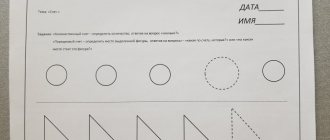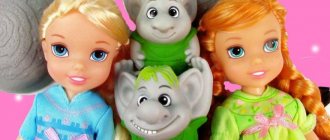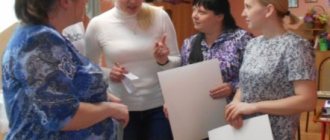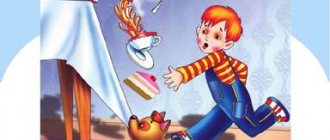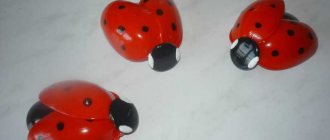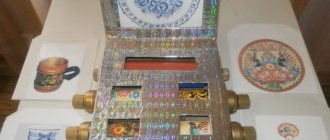DIY math games
Elena Margelova
DIY math games
Game “Collect a fly agaric”
Goal: to consolidate the ability to correlate quantity and number.
Materials : Separate fly agaric caps with different numbers of white dots within 10, and separately fly agaric legs with numbers from 1 to 10.
Description: You can play either individually or as a whole group, taking turns going out and looking for the right hat with the required number of white dots for the leg with the selected number. (children do not see what number the leg will come up with, they are turned upside down, and the child draws to choose from)
Game “Collect a Caterpillar”
Goal: to consolidate knowledge about numbers and their place in the series of natural numbers.
Materials : separate parts of the caterpillar with different numbers within 10.
Description: Each part of the caterpillar is scattered randomly, children collect it in order.
Game “PICK UP THE CLOTHESPICK”
Goal: consolidation of knowledge about the relationship between quantity and number within 10, repetition of the names of geometric shapes, development of fine motor skills.
Materials : drum with sectors in which different geometric shapes are located in different quantities within 10. Clothespins with numbers.
Description: Children are given clothespins with numbers and a tape measure with different numbers of geometric shapes. You can spin the roulette, determining the number of geometric shapes in the drawn sector, name them and find a clothespin with the required number, or you can simply turn the circle over and attach clothespins with the required numbers, while naming the geometric shapes.
Game "FISHING"
Goal: strengthening the skill of solving examples within 10, forming ideas about the composition of numbers within 10.
Materials : cardboard buckets, fish with examples within 10 of addition and subtraction.
Description: You can work individually with one child, he puts the fish in the right buckets, or you can work with a group of children, who will fill the buckets with fish faster and correctly.
Game "GUESS WHICH CHICKEN IS LOST?"
Goal: determine the place of the number in the natural series, name the missing number.
Materials : chicken figures with numbers from 1 to 10.
Description. The chickens are displayed in natural row sequence. Invites the children to look at how they stand, to see if any numbers are missing. After the children guess which chicken is missing, the hidden one is shown and put in its place.
You can use chickens in other tasks, for example: chickens are placed randomly, and children line them up in the correct sequence.
Game “GUESS WHICH IS THE COUNT...”
Goal: to consolidate the skill of ordinal counting.
Description. On a typesetting canvas or on a board, all the heroes of the fairy tale “Turnip”
.Task: “Now we will play the game
“Guess which hero I hid?”
Look how many heroes there are? After listening to the children’s answers, he explains the task: “Try to remember in what order the characters are located. Then I will hide the first hero, and you will tell me which one he was. Who wants to count the heroes in order? The child counts: The first is the grandfather, the second is the woman, etc. Then the children close their eyes, and the teacher removes one hero. The exercise is repeated several times.
Didactic games in mathematics for preschoolers
Do-it-yourself mathematical games for kindergarten
Author : Elena Nikolaevna Petrichenko, senior teacher of the Children's Educational Institution "DSOV No. 50" of the village of Novomyshastovskaya description of the material: didactic board games made of cardboard for working with preschool children. Can be used by teachers and parents. Used in classes on the formation of elementary mathematical concepts. Goal : development of elementary mathematical concepts and logical thinking. tasks : 1. develop logical thinking 2. form and consolidate the concept of the quantitative value of a number up to 20 3. form and consolidate the concept <,>, = 4. consolidate counting within 20
Game “Feed the Penguin”
goal: study and consolidate counting in the range from 10 to 20. material: cardboard penguins with numbers on their stomachs, a set of cardboard fish.
Progress of the game: children are given penguins, all the fish are laid out in the middle of the table. Children need to “feed” their penguin with fish, placing the number of fish near it that is indicated on the tummy. The one who does it faster and correctly wins.
Game “Easter Hen”
Purpose : to consolidate the quantitative composition of numbers and ordinal counting from 1 to 12. Material : cardboard chicken with a window for a ruler, cardboard ruler with numbers, a set of cardboard Easter eggs
Progress of the game: a number is set in the window on the chicken using a ruler. The child selects as many eggs for the chicken as indicated in the window.
Game “Crocodiles”
Purpose: to introduce and reinforce the concepts of “more”, “less” and “equal” Material: cardboard cards with numbers from 1 to 10. cardboard signs “<,>,=” in the form of crocodiles.
Progress of the game: children are given two cards with numbers and a set of signs <,>,=. The task is given to put the required sign between the cards. The one who does it correctly and quickly wins.
The following version of the game is also possible: children are given counting cardboard material and are asked to place a certain number of pictures on the left and right in a column (for example, 7 and 5). Then the children are asked to put a <, >, = sign between the columns.
Game “Insects”
Purpose: formation of logical thinking, orientation on the sheet, on the cells. material: blank 4×4 cell board, set of cardboard insects: flies, ladybugs, bees, diagram cards.
Progress of the game: the child is given an empty tablet, a diagram and a set of insects. You need to place the insects on an empty plate in accordance with the marks on the diagram. fly - black circle bee - yellow circle ladybug - red circle From the beginning, the child is offered simple diagrams, where not the entire tablet is filled in, then the tasks become more complicated.
scheme:
We recommend watching:
Didactic games - coloring pages to strengthen counting skills for children 3-5 years old Games with a mathematical tablet for kindergarten Mathematical game with Cuisenaire sticks for children 5-6 years old Games for preschoolers with Cuisenaire sticks
Similar articles:
Methods for early teaching children mathematics
Games for teaching mathematics to children 3-6 years old
Poems for teaching children to count
Math problems games for preschoolers
Logic games in mathematics for preschoolers
Creative materials
Anything you have can be useful. In total, you need to make three trees, several fruits of three types (for us these will be plums, pears and apples), three plates for them, and also, if desired, leaves. In order for children to develop their sensory skills as best as possible, it is worth making parts from different materials. It could be:
- Felt. Do-it-yourself didactic games made from this material are considered one of the best, since it is wear-resistant, has many beautiful colors and is easy to create.
- Rubber (or rubberized colored paper).
- Cardboard (thin and thick).
- Self-adhesive paper.
- A box or casket in which you can put parts of a didactic game.
- Of course, for the DIY process you will need scissors, a needle, colored threads (preferably floss), and a ruler. We also used green gouache to paint the back of the trees.
Non-traditional benefits for preschool children according to FEMP
- January 8, 2016
Festival “Golden Handicraft – 2015”
Section “Pedagogical Workshop”
Nomination "Magic Needle"
I bring to your attention teaching aids made for preschool children on the formation of elementary mathematical concepts. Working as a kindergarten teacher, I really love making crafts for my students. I sew not only toys for children from felt and fleece, but also various teaching aids that are useful for children. They help with work, and children love them for their unusualness and brightness, and enjoy spending a long time playing homemade games, developing fine motor skills, memory, attention, and logic.
Games can be used in subgroups or individually, both as play and learning activities. These games are suitable for preschool children from 2 to 7 years old. They are easy to make from scrap materials, or like I did, from felt and fleece.
Lacing “Collect flowers”
Using the game, you can introduce your child to color, size, and counting. Lacing promotes the development of fine motor skills, allows children to develop the ability to control their achievements, initiative and independence, and the ability to exert volition.
"Magnetic numbers"
Games made of felt on magnets will help the child get acquainted with numbers in a playful way, independently correlate the number of figures with a number, get acquainted with the number series, and lay out numbers in forward and reverse order.
Lacing “Geometric Shapes”
The set contains geometric shapes made of decorative foam. There are holes for lacing along the edge of the figure; you can attach figures of the same color or shape, or by number.
Game "Colored Dominoes"
The game consists of 28 cards, 7 colors. The principle of the game is the same as in a regular domino, but instead of numbers there are multi-colored circles. The game will introduce children to 7 colors, develop interest in board games, teach perseverance and the ability to play with other children.
Game “Assemble a circle from parts”
The game will introduce children to dividing a circle into 2, 4 and 8 parts. You can come up with many other games.
Game "Caterpillar"
Game on magnets, for fixing numbers, neighbors of numbers, forward and backward counting. Teaches children to match the number of objects to each number. You can play additional games: “What number is missing”, “Show what number the caterpillar shows”, etc.
These are the kind of teaching aids I make for my kindergarten students; children play with them with pleasure, they are durable, easy to wash, very bright and attractive to play with. Thank you for your attention, I will be glad if you like my teaching aids. Good luck with your work!
Internet resources used in this work:
https://www.maam.ru/detskijsad/matematicheskaja-igra-volshebnaja-gusenica.
htmlhttps://www.maam.ru/detskijsad/didakticheskaja-igra-veselaja-shnurovka.html.
Author: Tomareva Larisa Vasilievna, teacher of the highest qualification category, MADOU d/s No. 118 building 3 of the city of Tyumen.
Information portal for parents and educators
Do-it-yourself mathematical didactic game for the younger group.
Children's development largely occurs through play. Children 2-3 years old, who are just joining the ranks of preschoolers, begin to spend a lot of time in a group of peers, gaining new knowledge. Do-it-yourself didactic games are especially valuable in preschool educational institutions. This is the warmth and care of a master who puts his soul into each child, as well as the opportunity to give children sensory development and first skills in mathematics and logic. We present to your attention a master class on creating a bright didactic game with a mathematical bias for the younger group of preschool educational institutions, which older preschoolers will also enjoy playing. The process is accompanied by pictures, so it will be easier for you to create.
